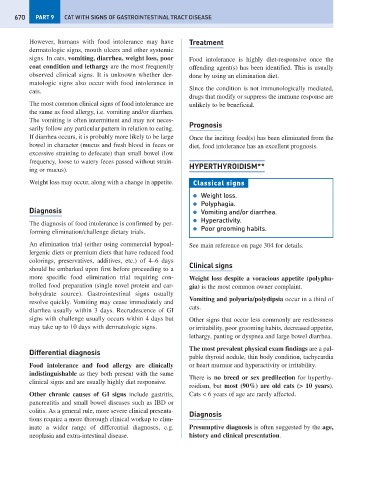Page 678 - Problem-Based Feline Medicine
P. 678
670 PART 9 CAT WITH SIGNS OF GASTROINTESTINAL TRACT DISEASE
However, humans with food intolerance may have Treatment
dermatologic signs, mouth ulcers and other systemic
signs. In cats, vomiting, diarrhea, weight loss, poor Food intolerance is highly diet-responsive once the
coat condition and lethargy are the most frequently offending agent(s) has been identified. This is usually
observed clinical signs. It is unknown whether der- done by using an elimination diet.
matologic signs also occur with food intolerance in
Since the condition is not immunologically mediated,
cats.
drugs that modify or suppress the immune response are
The most common clinical signs of food intolerance are unlikely to be beneficial.
the same as food allergy, i.e. vomiting and/or diarrhea.
The vomiting is often intermittent and may not neces- Prognosis
sarily follow any particular pattern in relation to eating.
If diarrhea occurs, it is probably more likely to be large Once the inciting food(s) has been eliminated from the
bowel in character (mucus and fresh blood in feces or diet, food intolerance has an excellent prognosis.
excessive straining to defecate) than small bowel (low
frequency, loose to watery feces passed without strain- HYPERTHYROIDISM**
ing or mucus).
Weight loss may occur, along with a change in appetite. Classical signs
● Weight loss.
● Polyphagia.
Diagnosis ● Vomiting and/or diarrhea.
● Hyperactivity.
The diagnosis of food intolerance is confirmed by per-
● Poor grooming habits.
forming elimination/challenge dietary trials.
An elimination trial (either using commercial hypoal- See main reference on page 304 for details.
lergenic diets or premium diets that have reduced food
colorings, preservatives, additives, etc.) of 4–6 days Clinical signs
should be embarked upon first before proceeding to a
more specific food elimination trial requiring con- Weight loss despite a voracious appetite (polypha-
trolled food preparation (single novel protein and car- gia) is the most common owner complaint.
bohydrate source). Gastrointestinal signs usually
Vomiting and polyuria/polydipsia occur in a third of
resolve quickly. Vomiting may cease immediately and
cats.
diarrhea usually within 3 days. Recrudescence of GI
signs with challenge usually occurs within 4 days but Other signs that occur less commonly are restlessness
may take up to 10 days with dermatologic signs. or irritability, poor grooming habits, decreased appetite,
lethargy, panting or dyspnea and large bowel diarrhea.
The most prevalent physical exam findings are a pal-
Differential diagnosis
pable thyroid nodule, thin body condition, tachycardia
Food intolerance and food allergy are clinically or heart murmur and hyperactivity or irritability.
indistinguishable as they both present with the same
There is no breed or sex predilection for hyperthy-
clinical signs and are usually highly diet responsive.
roidism, but most (90%) are old cats (> 10 years).
Other chronic causes of GI signs include gastritis, Cats < 6 years of age are rarely affected.
pancreatitis and small bowel diseases such as IBD or
colitis. As a general rule, more severe clinical presenta- Diagnosis
tions require a more thorough clinical workup to elim-
inate a wider range of differential diagnoses, e.g. Presumptive diagnosis is often suggested by the age,
neoplasia and extra-intestinal disease. history and clinical presentation.

